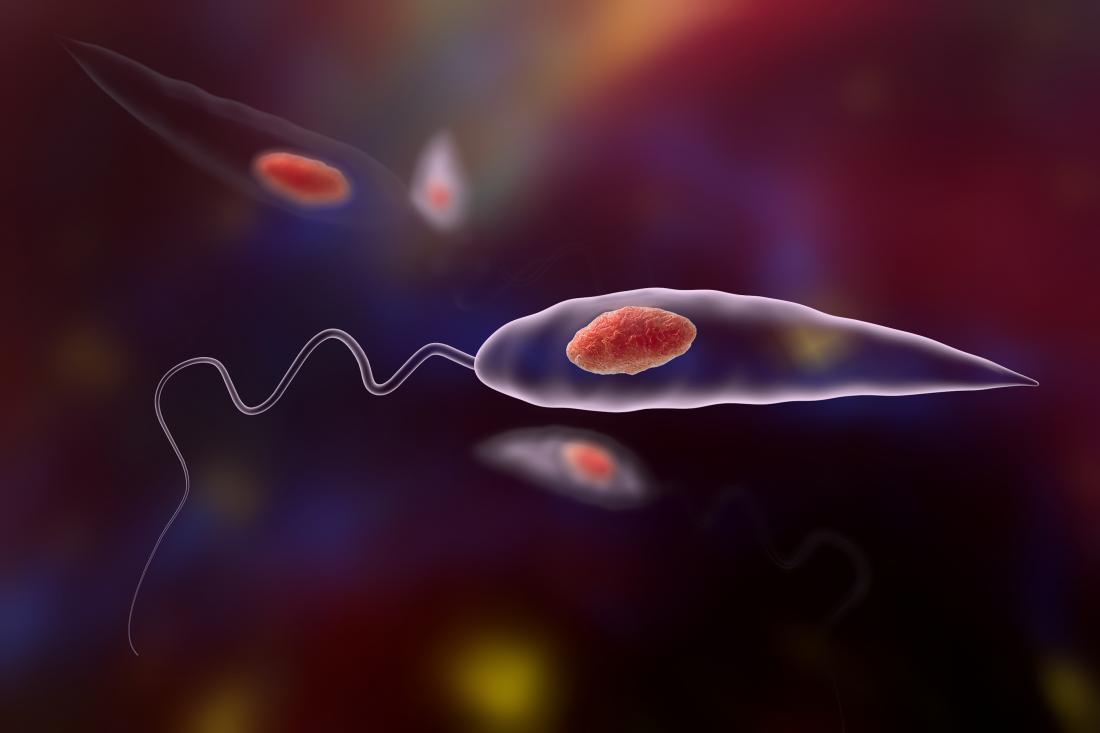Promastigotes of Leishmania parasite which are found in mosquito midgut or laboratory cultures.
Soil-transmitted helminth infections
Helminth infections are caused by several species of parasitic worm, including hookworms, whipworms and roundworms. Infected individuals suffer from anaemia, vitamin A deficiency, stunted growth, malnutrition and impaired development. Infection is particularly common in disadvantaged communities in tropical and subtropical countries with poor sanitation. The worms are transmitted from contaminated soil and faecal matter to people via unwashed or raw food, or dirty hands. Mature worms attach themselves in the small or large intestine and can live there for many years, producing thousands of eggs that are passed out through defecation, initiating the cycle all over again. An estimated 1.5 billion people—nearly a quarter of the world’s population—suffer from helminth infections.
Schistosomiasis
Schistosomiasis, also known as bilharzia, is caused by parasitic blood flukes that cause immune reactions and progressive damage to organs. Other symptoms include abdominal pain, diarrhoea, liver enlargement and hypertension of the abdominal blood vessels. Freshwater snails serve as intermediary hosts, releasing the larval parasite that can penetrate human skin. People can become infected during agricultural, domestic or recreational activities, which expose them to infested freshwater resources. The worms live in human blood vessels where females release eggs. These are passed out of the body in faeces or urine, continuing their life cycle. Over 200 million people required treatment worldwide in 2016.
Dengue
With about half the world’s population living in areas at risk of infection, the dengue virus is one of the leading causes of illness and death in the tropics and subtropics. Spread by mosquitoes, this viral infection causes flu-like illnesses, which can develop into a potentially lethal complication called severe dengue. Before 1970, only nine countries had experienced severe dengue. Recent estimates indicate dengue infections have jumped significantly to 390 million per year, and severe dengue is a leading cause of death among children in some Asian and Latin American countries. The disease is now endemic in more than 100 countries, with the Americas, South-East Asia and Western Pacific regions most severely affected. There is no specific treatment for dengue fever. For severe dengue, maintaining the patient’s body fluid is critical to survival.
Lymphatic filariasis
Microscopic, thread-like worms cause lymphatic filariasis. The disease leads to swollen tissues and elephantiasis, an abnormal enlargement of body parts causing pain, severe disability and social stigma. The adult worms occupy the lymphatic system and can live there for up to seven years. After mating, the worms release millions of microfilariae into the blood. When mosquitoes feed on an infected person, they can transfer the infection to others via bites. Lymphatic filariasis affects over 120 million people in 73 countries throughout the tropics and subtropics in Asia, Africa, the Western Pacific and South America.
Leishmaniasis
The Leishmania parasite causes leishmaniasis, also known as kala-azar. Leishmania parasites multiply in the gut of a sand fly, which transmits it to vertebrate hosts. In humans, symptoms of the disease include debilitating ulcers of the skin, mouth and nose. Visceral leishmaniasis is its most serious form and commonly leads to fever, low red blood cell count and liver and spleen enlargement. Left untreated, the fatality rate in developing countries can be as high as 100% within two years. About half of the cases of visceral leishmaniasis, as well as lymphatic filariasis and leprosy, occur in India and South Asia.
Treatment
‘Preventive chemotherapy’ is a promising intervention to combat lymphatic filariasis, schistosomiasis, soil-transmitted helminth infections and other neglected tropical diseases. In contrast to cancer chemotherapy, it is used to reduce the risk of infection or death in large public health campaigns. Six different medicines can be administered in seven different combinations, making it possible to target multiple diseases at once.
-------------------------------------------------------------------------------
Asia Research News is our annual magazine to highlight exciting research studies from our partners. 25,000 copies are printed and distributed to key figures in research. Download a PDF copy from the link below or contact us if you would like print copies.



